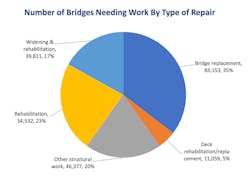Quarter Million Bridges Need Major Work: ARTBA
Some 37 percent of the nation’s bridges need major repair work or total replacement, according to the American Road & Transportation Builders Association (ARTBA).
ARTBA identified 231,000 bridges in its 2020 Bridge Report, and said 81,000—or 35 percent—should be replaced. About 46,000 are rated in poor condition and classified as “structurally deficient.”
ARTBA analyzed the U.S. Department of Transportation’s 2019 National Bridge Inventory database to prepare its bridge report. ARTBA’s chief economist, Dr. Alison Premo Black, led the team conducting the analysis.
“At the current pace, it would take more than 50 years to repair America’s structurally deficient bridges,” Black said in a prepared statement. “Our bridge network is underfunded and should be modernized. State and local government just haven’t been given the necessary financial resources to fully address the problem.”
The report comes as Congress and the Trump administration continue working on measures to respond to the impacts of the Covid-19 pandemic. ARTBA says once policy makers shift from a rescue focus to economic recovery, robust transportation infrastructure investments have comprehensive benefits.
“Economic recovery from coronavirus begins with strategic road and bridge improvements,” ARTBA president Dave Bauer said in a statement. “Increased transportation investments support direct job creation and retention, while putting in place capital assets that will enhance U.S. productivity for decades to come.”
He said the Senate Environment & Public Works Committee’s July 2019 unanimously approved five-year highway reauthorization bill should be the starting point for discussions.
“The sooner we invest in robust new transportation improvements the sooner the American people will experience the economic benefits,” Bauer said.
ARTBA estimates the cost to make the identified repairs for all 231,000 bridges in the U.S. at nearly $164 billion, based on average cost data published by the Federal Highway Administration (FHWA.)
What states have the worst bridges?
Although these bridges may not be imminently unsafe, they need attention, according to ARTBA. Over 69,500 bridges across the country are “posted for load” which means there are weight restrictions or other measures in place to reduce stress on the structure.
States with the largest actual number of structurally deficient bridges are:
- Iowa (4,575 bridges)
- Pennsylvania (3,501)
- Illinois (2,407)
- Oklahoma (2,352)
- Missouri (2,147)
- California (1,797)
- New York (1,745)
- North Carolina (1,714)
- Louisiana (1,701)
- West Virginia (1,531)
States with the most structurally deficient bridges as a percent of their total bridge inventory, are Rhode Island (22.3 percent)
- West Virginia (21 percent)
- Iowa (19 percent)
- South Dakota (17 percent)
- Pennsylvania (15.3 percent)
- Louisiana (13.2 percent)
- Maine (12.8 percent)
- Puerto Rico (12.3 percent)
- Michigan (10.8 percent)
- North Dakota (10.7 percent)
Over the last five years, according to ARTBA, Pennsylvania has reduced the number of its structurally deficient bridges by 1,200. Other states with large decreases include Oklahoma (753), Indiana (467), Ohio (412), and Virginia (391). In 12 states, the number of structurally deficient bridges increased over the five years, including West Virginia (472), Illinois (260), Florida (131), Missouri (80), and Montana (77).
What are notable bad bridges?
Notable structurally deficient bridges include New York City’s Brooklyn Bridge; Washington, D.C.’s Theodore Roosevelt bridge; the San Mateo-Hayward bridge crossing San Francisco Bay; Florida’s Pensacola Bay Bridge; and the Vicksburg Bridge in Mississippi.
Source: ARTBA
